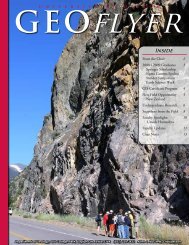Stander Symposium abstract book - University of Dayton
Stander Symposium abstract book - University of Dayton
Stander Symposium abstract book - University of Dayton
Create successful ePaper yourself
Turn your PDF publications into a flip-book with our unique Google optimized e-Paper software.
ORAL PRESENTATIONS<br />
order to further research on the level <strong>of</strong> student civic engagement at the <strong>University</strong> <strong>of</strong> <strong>Dayton</strong>. We hope this research will help fellow student organizations<br />
understand the most effective practices around increasing student engagement in the city <strong>of</strong> <strong>Dayton</strong>. To gather data, the cohort is utilizing<br />
a variety <strong>of</strong> survey tools to assess the effectiveness <strong>of</strong> event marketing,reasons why students choose not to engage the city <strong>of</strong> <strong>Dayton</strong>, and what<br />
kinds <strong>of</strong> opportunities students prefer. A campus wide survey was conducted at the outset <strong>of</strong> the project to collect data. Students who participate<br />
in Destination <strong>Dayton</strong> events complete a pre and post-survey at each event. Finally, a follow up survey is sent to participants two weeks following<br />
each event to assess their continuing level <strong>of</strong> engagement. Two events have taken place thus far, a “Sweetheart Skate” at RiverScape Ice Rink, and<br />
an egg hunt service event at Cleveland Elementary School. This Friday, Destination <strong>Dayton</strong> will be taking students to a <strong>Dayton</strong> Dragons game,<br />
which will conclude the planned events for this semester. Next semester, Destination <strong>Dayton</strong> will be looking to disseminate the results <strong>of</strong> our<br />
research to other groups on campus. In effect, we hope this strengthens the relationship between our campus and the larger <strong>Dayton</strong> community.<br />
<strong>Dayton</strong> Civic Scholars Senior Capstone Project<br />
Presenter(s): Katherine Gonzalez, Bernard D Jones, Katarina A Lucas, Lauren E Maddente, John E McGinnis,<br />
Lisa A Ramsey, Lauren A Simcic, Michael J Veselik<br />
Advisor(s): Alexandra L Robinson<br />
Fitz Center for Leadership in Commun<br />
3:00 PM-4:00 PM<br />
Senior/Capstone Project<br />
LTC - Studio<br />
A core component <strong>of</strong> the <strong>Dayton</strong> Civic Scholars program is the senior capstone project. This presentation is about the 2012 cohort project. This<br />
project was done in conjunction with students at Meadowdale High School with an emphasis on their futures. This presentation is about how the<br />
project was chosen, the planning process, successes, barriers, and the implementation <strong>of</strong> the two events that were planned.<br />
GEOLOGY<br />
Changes in Precipitation Regimes in the United States<br />
Presenter(s): Thomas A Davis<br />
Advisor(s): Shuang-Ye Wu<br />
Geology<br />
3:40 PM-4:00 PM<br />
Senior/Capstone Project Kennedy Union - 312<br />
This study aims to investigate how climate change has affected precipitation patterns in the US. Precipitation provides us with freshwater, the<br />
most vital resources for life; but it also brings damages from extreme storms and flooding. There are three major mechanisms <strong>of</strong> precipitation in<br />
the United States: (1) frontal storms dominate during colder months from late fall to early spring and generally last for longer periods <strong>of</strong> time;<br />
(2) convective storms or ‘pop-up thunderstorms’ are more common during late spring and summer, and typically bring more intense rainfall for<br />
shorter period <strong>of</strong> time, and (3) precipitation due to orographic lifting in mountainous regions. The objectives <strong>of</strong> this study are to establish (1) if<br />
precipitation regimes have changed in the United States in the past 60 years as a result <strong>of</strong> climate change, and (2) if changes in precipitation patterns<br />
are similar for different types <strong>of</strong> storms and (3) if changes in precipitation patterns are similar in different climate regions. For this purpose,<br />
we used hourly and daily precipitation data from 1900 through 2010 collected from National Climate Data Center and US Historical Climatology<br />
Network to look for trends in the frequency and intensity <strong>of</strong> storms <strong>of</strong> various durations, and examine the statistical significance <strong>of</strong> these trends.<br />
The investigation is conducted in GIS in order to examine spatial variations <strong>of</strong> such changes<br />
117

















